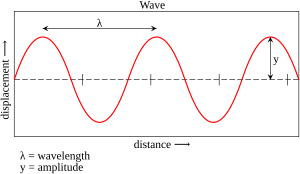Physics Course/Waves
Waves
Waves are disturbances travelling in a medium. Wave is a periodic oscillation travels through medium at Speed v and carries an energy E
Waves are divided in two types of waves. Waves that have the direction of oscillation the same as the direction of travel are called Transverse Waves. Waves that have the direction of oscillation perpendicular to the direction of the travel are called Longitudinal Waves.
Wave Characteristics
- Wavelength
- Wavelength is defined as distance between two peaks of the wave
- λ = 2π
- Speed
- Angular of Speed
- Frequency of Time
- Amplitude
- at . Amplitude of the wave equals to zero at angle of nπ
- at . Amplitude of the wave equals to the peak value at angle of (2n+1)π/2
- Wave's Function
Wave's Equation
Every wave can be expressed by a derivative equation. The simplest form of a wave's oscillation travels in direction x in time t
v is the speed of wave travelling. Root of the wave's equation is solved by Jean le Rond d'Alembert:
Can be described as the sum of periodic waves
- A(x, t) is the amplitude of the wave,
- ω Angular Velocity
- k Wave's Number
- φ Angle.
If Amplitude does not depend on time is called Standing Wave
Wave's Examples
Wave Speed Frequency Wave Length Energy Light Wave C = 3 x 1018 m/s Sound Wave V = λ f = 300 m/s Electric Wave 60Hz ElectroMagnetic Wave C = 3 x 1018 m/s MHz - THz λ = C / f E = h f = h nfo Black Body Radiation Light Wave V
C
Cf < fo
f = fo
f > foλ = v / f
λ = C / fo
λ = C / nfoE = m v2
E = h fo
E = h nfo
Summary
Wave is used to describe a motion of an oscillation through space. There are two types of waves.
- Transverse Wave has the oscillation's direction the same direction of oscillation. For instance, Electric Wave.
- Longitudianl Wave has the oscillation's direction perpendicular to the direction of oscillation. For example, Sound Wave
Every Wave has a Wave's Equation in the form
Wave Amplitude Wave Length Speed Period Phase Angle 
A wave with constant amplitude. at angle
at angle
Wave could carry Energy, Information. Wave's speed can be changed by Reflection, Refraction, Diffraction even undergo Frequency change by Energy Absorption or Radiation.





















